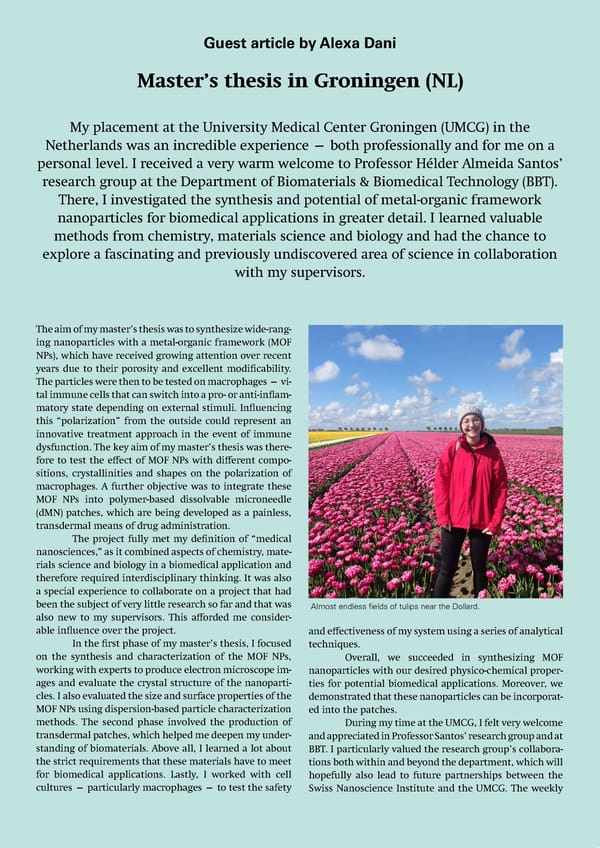Guest article by Alexa Dani Master’s thesis in Groningen (NL) My placement at the University Medical Center Groningen (UMCG) in the Netherlands was an incredible experience — both professionally and for me on a personal level. I received a very warm welcome to Professor Hélder Almeida Santos’ research group at the Department of Biomaterials & Biomedical Technology (BBT). There, I investigated the synthesis and potential of metal-organic framework nanoparticles for biomedical applications in greater detail. I learned valuable methods from chemistry, materials science and biology and had the chance to explore a fascinating and previously undiscovered area of science in collaboration with my supervisors. The aim of my master’s thesis was to synthesize wide-rang- ing nanoparticles with a metal-organic framework (MOF NPs), which have received growing attention over recent years due to their porosity and excellent modi昀椀cability. The particles were then to be tested on macrophages — vi- tal immune cells that can switch into a pro- or anti-in昀氀am- matory state depending on external stimuli. In昀氀uencing this “polarization” from the outside could represent an innovative treatment approach in the event of immune dysfunction. The key aim of my master’s thesis was there- fore to test the e昀昀ect of MOF NPs with di昀昀erent compo- sitions, crystallinities and shapes on the polarization of macrophages. A further objective was to integrate these MOF NPs into polymer-based dissolvable microneedle (dMN) patches, which are being developed as a painless, transdermal means of drug administration. The project fully met my de昀椀nition of “medical nanosciences,” as it combined aspects of chemistry, mate- rials science and biology in a biomedical application and therefore required interdisciplinary thinking. It was also a special experience to collaborate on a project that had been the subject of very little research so far and that was Almost endless 昀椀elds of tulips near the Dollard. also new to my supervisors. This a昀昀orded me consider- able in昀氀uence over the project. and e昀昀ectiveness of my system using a series of analytical In the 昀椀rst phase of my master’s thesis, I focused techniques. on the synthesis and characterization of the MOF NPs, Overall, we succeeded in synthesizing MOF working with experts to produce electron microscope im- nanoparticles with our desired physico-chemical proper- ages and evaluate the crystal structure of the nanoparti- ties for potential biomedical applications. Moreover, we cles. I also evaluated the size and surface properties of the demonstrated that these nanoparticles can be incorporat- MOF NPs using dispersion-based particle characterization ed into the patches. methods. The second phase involved the production of During my time at the UMCG, I felt very welcome transdermal patches, which helped me deepen my under- and appreciated in Professor Santos’ research group and at standing of biomaterials. Above all, I learned a lot about BBT. I particularly valued the research group’s collabora- the strict requirements that these materials have to meet tions both within and beyond the department, which will for biomedical applications. Lastly, I worked with cell hopefully also lead to future partnerships between the cultures — particularly macrophages — to test the safety Swiss Nanoscience Institute and the UMCG. The weekly SNI INSight December 2024 18
 SNI INSight December 2024 Page 17 Page 19
SNI INSight December 2024 Page 17 Page 19